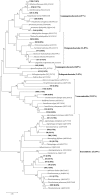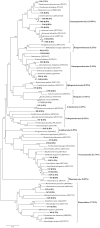Degradation of potassium rock by earthworms and responses of bacterial communities in its gut and surrounding substrates after being fed with mineral
- PMID: 22174903
- PMCID: PMC3236767
- DOI: 10.1371/journal.pone.0028803
Degradation of potassium rock by earthworms and responses of bacterial communities in its gut and surrounding substrates after being fed with mineral
Abstract
Background: Earthworms are an ecosystem's engineers, contributing to a wide range of nutrient cycling and geochemical processes in the ecosystem. Their activities can increase rates of silicate mineral weathering. Their intestinal microbes usually are thought to be one of the key drivers of mineral degradation mediated by earthworms,but the diversities of the intestinal microorganisms which were relevant with mineral weathering are unclear.
Methodology/principal findings: In this report, we show earthworms' effect on silicate mineral weathering and the responses of bacterial communities in their gut and surrounding substrates after being fed with potassium-bearing rock powder (PBRP). Determination of water-soluble and HNO(3)-extractable elements indicated some elements such as Al, Fe and Ca were significantly released from mineral upon the digestion of earthworms. The microbial communities in earthworms' gut and the surrounding substrates were investigated by amplified ribosomal DNA restriction analysis (ARDRA) and the results showed a higher bacterial diversity in the guts of the earthworms fed with PBRP and the PBRP after being fed to earthworms. UPGMA dendrogram with unweighted UniFrac analysis, considering only taxa that are present, revealed that earthworms' gut and their surrounding substrate shared similar microbiota. UPGMA dendrogram with weighted UniFrac, considering the relative abundance of microbial lineages, showed the two samples from surrounding substrate and the two samples from earthworms' gut had similarity in microbial community, respectively.
Conclusions/significance: Our results indicated earthworms can accelerate degradation of silicate mineral. Earthworms play an important role in ecosystem processe since they not only have some positive effects on soil structure, but also promote nutrient cycling of ecosystem by enhancing the weathering of minerals.
Conflict of interest statement
Figures










References
-
- Burford EP, Fomina M, Gadd GM. Fungal involvement in bioweathering and biotransformation of rocks and minerals. Mineralogical Magazine. 2003;67:1127–1155.
-
- Gadd GM. Geomycology: biogeochemical transformations of rocks, minerals, metals and radionuclides by fungi, bioweathering and bioremediation. Mycological Research. 2007;111:3–49. - PubMed
-
- Li S, Li FC, Cheng LJ. Recent development in bio-weathering research. Mineral resources and geology. 2006;20:577–582.
-
- Goudie AS. Organic agency in calcrete development. Journal of Arid Environments. 1996;32:103–110.
-
- Suzuki Y, Matsubara T, Hoshino M. Breakdown of mineral grains by earthworms and beetle larvae. Geoderma. 2003;112:131–142.
Publication types
MeSH terms
Substances
LinkOut - more resources
Full Text Sources
Medical
Molecular Biology Databases

